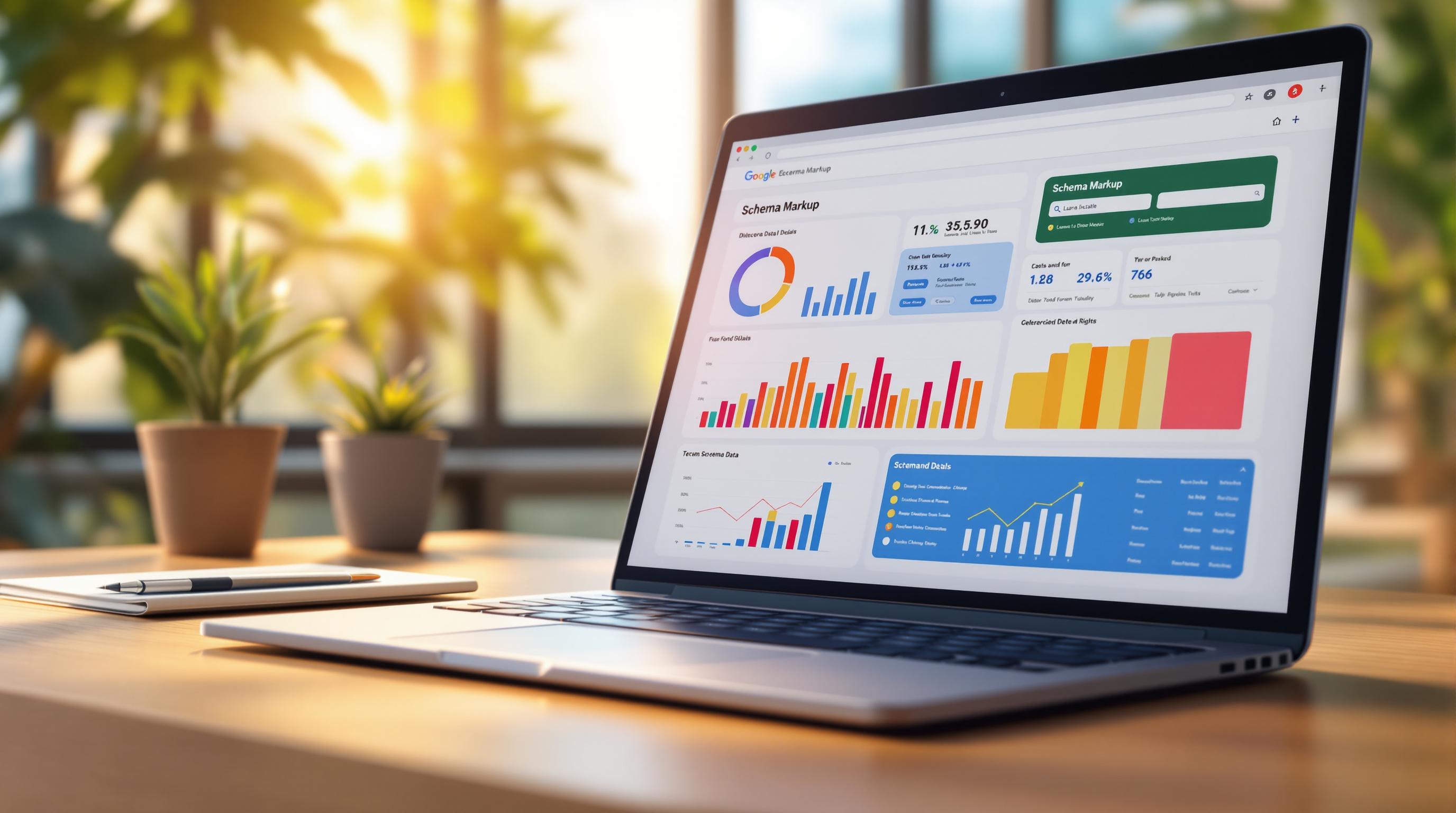Analyzing competitor traffic helps you identify what works in your industry and refine your strategy. Here's the quick takeaway:
- Understand Traffic Channels: Look at organic, paid, social, and referral traffic to see where competitors excel.
- Monitor Metrics: Key indicators include bounce rate, time on site, and conversion data.
- Use SEO Tools: Platforms like Ahrefs and SEMrush provide insights into competitor keywords, backlinks, and campaigns.
- Spot Trends: Seasonal shifts, high-performing content, and audience behavior reveal opportunities.
- Actionable Steps: Improve your content, optimize SEO, and focus on channels driving the most traffic.
Quick Tip: Tools like Ahrefs and SEMrush can automate tracking and alert you to competitors' moves. Start by identifying direct and indirect competitors, then dive into their traffic sources and strategies.
Why It Matters: Knowing where competitors succeed helps you fill gaps, improve visibility, and drive more traffic to your site.
How to Analyze Competitors' Traffic Sources Using Analytics Tools
Finding Your Main Competitors
To strengthen your market presence, it's crucial to pinpoint competitors that are engaging your target audience. Here's how to figure out which competitors deserve your attention.
Competitor Research Methods
Competitors can be divided into two types: direct competitors, who target the same audience with similar products or services, and indirect competitors, who meet similar needs in different ways.
Here are a few ways to identify them:
-
Market Research Analysis
Use tools like Meltwater to conduct market research. For example, H&M Mexico used it to shape their campaign strategies . -
Customer Feedback Collection
Online communities and review sites can reveal both direct competitors and alternative options. This feedback can help refine your understanding of the competitive landscape. -
Search Results Analysis
Check search engine results pages (SERPs) for your main keywords. This can help you spot direct competitors and others overlapping in your space.
Top SEO Research Tools
Once you've identified your competitors, dive deeper with specialized SEO tools. Platforms like Ahrefs and SEMrush offer detailed insights into competitor traffic and strategies.
Industry leaders frequently highlight the value of Ahrefs:
"Without Ahrefs, we would lose hundreds of thousands of dollars in revenue each year" - Greg Heilers, Co-Founder of Jolly SEO
"We've added $80M of annual traffic value in the last two years and it wouldn't have been possible without Ahrefs" - IBM's Director of Digital Marketing, Bryan Casey
When selecting an SEO tool, evaluate key factors like data accuracy, market coverage, system integration, pricing, and ease of use. Considering that over 53% of website traffic stems from organic search , investing in a reliable SEO tool is a smart move for thorough competitor analysis.
sbb-itb-d7fe25c
Traffic Source Analysis
Looking at where competitors get their traffic can reveal strategies worth considering. Let’s break down the key channels and the metrics to watch.
Organic Search Performance
Organic search is often the top traffic driver for most websites. This makes it essential to understand how competitors perform in this area. Tools like Semrush and Ahrefs can provide detailed data on keyword rankings and content effectiveness .
Here’s what to keep an eye on:
- Keyword rankings: Which terms competitors rank for.
- Number of organic visitors: Estimate of their traffic volume from search engines.
- Average page views: How much content users consume per visit.
- Time on page: Indicates engagement levels.
- Bounce rates: Shows how often users leave without interacting further.
Why does this matter? Studies show that 90% of users don’t go past the first page of Google results . Securing top spots for the right keywords is critical for long-term traffic growth. From here, let’s examine how referral traffic plays into competitor strategies.
Referral Traffic Sources
Referral traffic gives insight into how competitors are building links and partnerships. Tools like Ahrefs, which updates its backlink index every 15–30 minutes , are ideal for tracking these metrics:
| Metric | What to Analyze |
|---|---|
| Domain Authority | Quality of the sites linking back. |
| Link Velocity | How quickly new backlinks are being added. |
| Content Types | What kind of content attracts backlinks. |
| Anchor Text | Keywords used in the backlinks. |
Understanding these factors can help you identify opportunities to replicate or improve upon their link-building efforts.
Paid Traffic Channels
Analyzing paid campaigns can uncover how competitors allocate their budgets and target audiences. Tools like iSpionage ($59/month) and Semrush ($117.33/month) are great for this.
Key elements to evaluate include:
- Active PPC campaigns: What ads they’re running.
- Ad copy variations: Messaging and creative approaches.
- Landing page strategies: How they convert visitors.
- Bidding patterns: Insights into their ad spend and competition.
Here’s an interesting stat from Google: 81% of ad impressions happen when there’s no organic result on the first page . This highlights how paid campaigns can fill gaps in organic visibility.
Social Media Traffic
Social media can be a strong traffic driver when used wisely. Tools like Sprout Social ($199/month) and Rival IQ ($239/month) offer detailed analytics to track competitor performance across platforms.
To analyze social media effectively, focus on:
- Engagement rates: Likes, shares, and comments.
- Content types and themes: What resonates with their audience.
- Posting frequency: How often they publish.
- Audience interaction patterns: How they engage with followers.
- Platform-specific performance: Which platforms drive the most traffic.
Using Competitor Data
Turn competitor insights into practical strategies that drive results.
Creating Action Plans
Use competitor data to prioritize key improvements. Here's a breakdown:
| Focus Area | Action Steps | Outcome |
|---|---|---|
| Content Strategy | Fill content gaps and refine existing pages | Boost in organic traffic |
| Technical SEO | Improve site speed and mobile performance | Better user experience |
| Backlink Profile | Secure links from high-authority sites | Stronger domain authority |
| Social Media Presence | Increase engagement on high-performing platforms | More traffic from social channels |
For example, if competitors are seeing success with video content, consider investing in video production. Set realistic goals and allocate resources accordingly.
Monitoring Changes
Keep track of your progress with regular reviews:
- Weekly: Monitor key metrics for immediate insights.
- Monthly: Assess broader trends and refine your strategy.
- Quarterly: Dive deeper into performance and adjust long-term plans.
Tools like Semrush and Ahrefs can help by sending automated alerts when competitors make notable moves. This allows you to respond quickly and stay competitive.
Professional SEO Support
Sometimes, expert help can make all the difference. BrightSide SEO (https://brightsideseo.com) offers tailored services to fast-track your improvements. Their offerings include:
- Detailed Audits: Identify opportunities based on competitor strategies.
- Custom Plans: Develop actionable roadmaps for traffic growth.
- Execution Support: Implement proven changes effectively.
BrightSide SEO’s results speak for themselves: their strategies have increased traffic by over 50% and boosted Shopify store sales by more than 30% .
Summary
Steps Overview
Here's a quick breakdown of the process:
| Phase | Key Activities | Expected Outcomes |
|---|---|---|
| Research | Identify competitors and set analysis goals | Clear view of the market landscape |
| Analysis | Study traffic sources, trends, and visitor behavior | Insights into what works |
| Implementation | Develop content, optimize channels, and fine-tune targeting | Boosted traffic and engagement |
| Monitoring | Track performance and adjust strategies regularly | Maintain a competitive edge |
Digging into competitor traffic reveals growth opportunities. It helps you understand total traffic, visitor behavior, and top-performing pages, which can serve as benchmarks for your own performance. As Claire Broadley says, "Reverse-engineering competitor strategies can help you attract more visitors to your own site" .
Use these findings as the basis for your next actions.
Next Steps
Turn insights into results:
- Track Key Metrics: Use tools like Semrush or Ahrefs to set up automated alerts for important metrics.
- Improve Your Content: Take note of the content formats that work for competitors, address gaps in your own content, and enhance existing pages.
- Fine-Tune Marketing Channels: Focus on the platforms and strategies that deliver the best return. For example:
- Target high-performing keywords.
- Get active on platforms where competitors thrive.
- Build partnerships with influential referral sources.
If you're unsure where to begin, consider hiring an expert SEO service to identify opportunities and implement effective strategies tailored to your needs.


